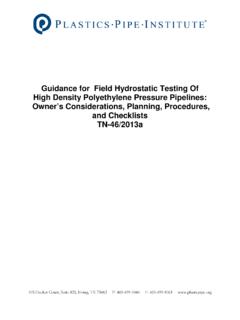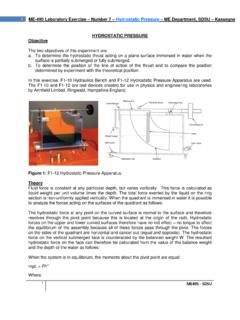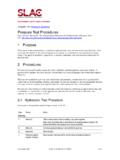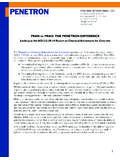Transcription of WHAT IS HYDROSTATIC TESTING? - CASP Aerospace
1 WHAT IS HYDROSTATIC TESTING? . HYDROSTATIC testing is the most common procedure used to qualify newly manufactured cylinders, spheres and tubes used for the transportation of dangerous goods. HYDROSTATIC testing is also required periodically to re-qualify these pressure vessels for continued service. During a HYDROSTATIC test, a pressure vessel is placed inside a closed system, usually a test jacket filled with water, and a specified internal water pressure is applied to the container inside this closed system. The applied internal pressure causes an expansion of the container being tested, and the total and permanent expansion that the container undergoes are measured. These volumetric expansion measurements, in conjunction with an internal and external visual inspection of the container, are used to determine if a pressure vessel is safe for continued use, or has suffered from a degradation in its structural integrity and must be condemned.
2 Some pressure vessels may be re-qualified by means of a proof- pressure test. This method, also known as a modified HYDROSTATIC test, consists of subjecting a pressure vessel to a specified internal pressure and inspecting the pressurized container for leaks, bulges or other defects. This method is permitted only when the applicable regulations do not require the determination of volumetric expansion measurements ( for certain types of low pressure cylinders such as those used on many portable fire extinguishers). pressure VESSEL MARKINGS . The manufacturer's markings on a pressure vessel include information regarding the date of manufacture, the manufacturers name or registered mark, the serial number of the unit and the specification or exemption to which the container complies.
3 For pressure vessels that have been re-qualified one or more times, additional markings indicate the date(s) of any previous HYDROSTATIC retests and identification markings of the retest facility. On steel cylinders, these markings are stamped into the shoulders of the cylinder. On spheres, the markings are stamped into the mounting brackets or the gauge guard, or they may be etched onto the surface of the sphere itself. The markings for fiber-wound cylinders are found on a nameplate and retest labels embedded in the epoxy of the cylinder body. The markings on low pressure cylinders are usually found on a label or nameplate. Typical specification markings found on aircraft pressure vessels.
4 Steel Oxygen or Inflation Cylinders . DOT-3AA 1800 DOT-3HT 1850. TC-3 AAM 124 TC-3 HTM 127. Fire Extinguisher Spheres . DOT-4DS 700 DOT-4D 500. DOT-4DA 800 DOT-E7945 750. Fiber-Wound Oxygen and Inflation Cylinders . DOT E8162-1850 DOT E11194 4050. DOT SP8162-1850 DOT SP11194 4050. TC SU 9209-127 TC SU4237-127. The first group of characters indicate the responsible regulatory agency ( DOT, TC, ICC, CTC). The second group of characters identify the container specification or exemption/special permit number ( 3AA, 4DS, E8162) and the third group identifies the rated service pressure of the container ( 1800 psi, 700 psi, 127 bar). HYDROSTATIC TEST MARKINGS . pressure vessels that have been hydrostatically tested and re-qualified must be marked by the retest facility with the facility retester identification number (RIN), and the retest date.
5 Depending on the age of the container, it may contain none or many sets of retest markings. The oldest date marked on the container is the date of the original HYDROSTATIC test carried out by the manufacturer, and is considered the manufacturing date. Any subsequent dates marked on the container are a record of the HYDROSTATIC tests that the container has undergone. The manner in which the markings are applied, and the required format for the markings are defined by the applicable regulations. Format specified by Transport Canada . 11 147 02. Format specified by the US Department of Transport . D0. 11 02. 96. 11 indicates the month of the retest (Nov.). 147 indicates the TC approved facility RIN.
6 D069 indicates the DOT approved facility RIN. 01 indicates the year of the retest (2001). Low pressure portable fire extinguishers must have all the HYDROSTATIC test information marked on a tamper-proof label affixed to the cylinder. HYDROSTATIC TEST INTERVALS . The HYDROSTATIC test interval and service life of various pressure vessels are generally determined by the specification or exemption to which the pressure vessel was manufactured. Specification Test Interval Service Life 3AA 5 year Unlimited 3HT 3 year 24 year 4DS 5 year Unlimited 4D 5 year Unlimited 4DA 5 year Unlimited E, SP and SU 3 or 5 year 15 year Fiber wound cylinders or spheres are usually manufactured to an Exemption or Special Permit ( DOT-E8162), and generally have a 3 or 5 year test interval and a 15 year service life.
7 The are also some steel containers manufactured to various exemptions. In either case, the testing and re-qualification of any pressure vessel manufactured to an exemption must be carried out in accordance with the criteria specified in a current copy of the applicable Exemption or Special Permit. Low pressure rechargeable portable fire extinguishers that are not manufactured to a DOT exemption generally require a 12 year HYDROSTATIC test and have an unlimited service life. Non-rechargeable units usually have a service life specified by the manufacturer ( 10 yrs.), but no HYDROSTATIC test requirement. Most small lavatory extinguishers are exempt from HYDROSTATIC testing, and containers not manufactured to a DOT or TC specification must be re-qualified in accordance with the requirements specified by manufacturer or design authority.
8 REGULATORY INFORMATION . The current bilateral airworthiness agreement between Canada and the does not cover the HYDROSTATIC testing of aircraft pressure vessels. Until such an agreement is put in place, pressure vessels intended for use in registered aircraft must be tested in accordance with requirements, and pressure vessels intended for use in Canadian registered aircraft must be tested to Canadian requirements. As a result, facilities engaged in HYDROSTATIC testing of pressure vessels used in Canadian registered aircraft must be approved by Transport Canada, and perform the test in accordance with Canadian standards. Likewise, Canadian companies testing pressure vessels for use in registered aircraft must have a DOT approval, and carry out the test in accordance with regulations.
9 REFERENCES . Airworthiness Notice No. B034 Edition 3, dated 13 February 1998, Certification of pressure Vessels, Canada Bilateral . Airworthiness Notice No. B067 Edition 1, dated 03 June 2003, "Inspection and Maintenance of Handheld Portable Fire Extinguishers and the HYDROSTATIC Testing of pressure Vessels used in Aircraft". Transport Canada, Transportation of Dangerous Goods Act & Regulations National Standard of Canada CAN/CSA-B339, Cylinders, Spheres and Tubes for the Transportation of Dangerous Goods . National Standard of Canada CAN/CSA-B340, "Selection and Use of Cylinders, Spheres, Tubes, and Other Containers forthe Transportation of Dangerous Goods, Class 2". National Standard of Canada CAN/ULC-S532-1990, "Servicing of Portable Fire Extinguishers".
10 Underwriters' Laboratories of Canada , "Servicing of Halon Extinguishing Systems". United States, Federal Aviation Administration, FAA Bulletin #HBAW 02-01A, Maintenance of pressure Cylinders in Use as Aircraft Equipment . United States, Code of Federal Regulations, Title 49, Part 180 (49 CFR180), Continuing Qualification and Maintenance of Packagings . National Fire Protection Association, NFPA 10, Standard for Portable Fire Extinguishers . Compressed Gas Association (CGA) Pamphlet C1, "Methods for HYDROSTATIC testing of Compressed Gas Cylinders". Compressed Gas Association (CGA) Pamphlet C5, "Cylinder Service Life-Seamless Steel High pressure Cylinders". Compressed Gas Association (CGA) Pamphlet C6, "Standards for Visual Inspection of Steel Compressed Gas Cylinders.






